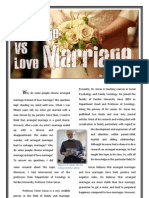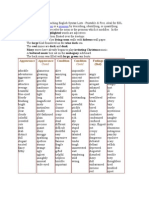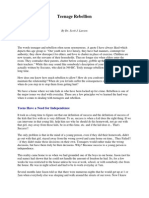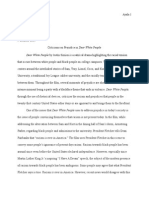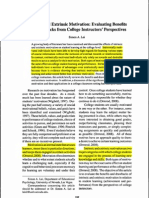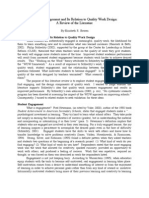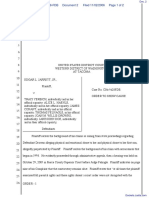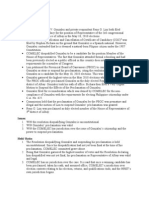Arranged Marriage
Arranged Marriage
Uploaded by
Siddhesh BhatewaraCopyright:
Available Formats
Arranged Marriage
Arranged Marriage
Uploaded by
Siddhesh BhatewaraCopyright
Available Formats
Share this document
Did you find this document useful?
Is this content inappropriate?
Copyright:
Available Formats
Arranged Marriage
Arranged Marriage
Uploaded by
Siddhesh BhatewaraCopyright:
Available Formats
Arranged Marriage A violation of human rights?
Ulrikke Madeleine Skeid Fossum Summer 2010 University of California, Berkeley Professor Kirk Boyd
Ulrikke Madeleine Skeid Fossum
Abstract
This paper examines the question of whether arranged marriages are a violation of human rights as they are protected by international humanitarian law. Arranged marriages are part of many cultures today, and have for a long time been part of every culture. Arranged marriages in this context are marriages where someone other than the spouses arranged the marriage, but both partners had the option of not marrying. This paper will first examine arranged marriage in a historical and cultural context, and then the protections against arranged marriage in various international agreements that exist today. The final part of the paper will look at the way these protections are presented in article 24 in the proposed International Bill of Rights. It also touches on the problems raised by the right to privacy presented in article 27, when possibly banning arranged marriages.
Ulrikke Madeleine Skeid Fossum
Table of Contents
Introduction.................................................................................4 Definition.....................................................................................4 History of Arranged Marriage........................................................5
Marriage in the Bible...........................................................................5 Marriage in Islam................................................................................6 Arranged Marriages in India.................................................................8 Royal Marriages..................................................................................9
International Agreements............................................................10 Regional Agreements..................................................................12 The International Bill of Human Rights.........................................14 Conclusion.................................................................................. 17
Changing the Language.....................................................................16
Ulrikke Madeleine Skeid Fossum
Introduction
Do arranged marriages violate human rights as they are protected by international humanitarian law? Marriage is a vital part of the social and economic life of a persons life. It forms the foundation for a continued family line, and the backdrop for raising children. In most societies, marriage is an important relation both between the two people and between the person and the society, and there are many rituals and traditions tied to the marriage. In many parts of the world, arranged marriages are still common, and are the expected and accepted way to find someone to share a lifetime with. This paper examines the question of whether arranged marriages are a violation of human rights as they are protected by international humanitarian law. Arranged marriages are part of many cultures today, and have for a long time been part of every culture. This paper will first examine arranged marriage in a historical and cultural context, and then move on to examining the protections against arranged marriage in various international agreements that exist today. The final part of the paper will look at the way these protections are presented in article 24 in the proposed International Bill of Rights, and other conflicting rights that make it difficult to protect people against arranged marriage.
Definition
A definitive distinction between arranged marriages and forced marriages is difficult to define, as the division is fluid. One distinction is to say that arranged marriages are marriages planned by parents, guardians and brokers, based on what they believe is the best for the spouses, but in this case, the intended future spouses hold the final say in whether to go through with the union of marriage. Forced marriages, on the other hand, completely lack the element of free consent, 4
Ulrikke Madeleine Skeid Fossum
either by lack of given consent or because consent is given under duress. The right to refuse an arranged marriage is perhaps not part of reality, since the spouses are brought up in a family environment where forced marriages are expected, and family bonds have powerful sway over individual decisions. The question that arises, therefore, is essentially to establish whether one or both future spouses have consented, and if so, whether the consent was full and free with the aim of entering into married life.1
History of Arranged Marriage
Because marriage is such an important part of human life, it is discussed and described in religious writings. Arranged marriages have been instrumental in maintaining royal families and dynasties through history, and in some cultures, such as the Indian, arranged marriages are still common.
Marriage in the Bible
At the time of many of the stories in the Bible, arranged marriages were very common. The pair that was to be married often had little power in deciding who they would marry; they would have to do as their parents decided. In the same way as in royal families, marriage tied groups together in alliances, bringing different communities together. Genesis 24 speaks of an arranged marriage, where a servant is sent to find a wife for Abrahams son Isaac. Rebekah is brought from her homeland to marry Isaac. She is given to Abrahams servant by her father Bethuel and brother Laban, to marry a man she has never met. Isaac is in the same situation as Rebekah, since he also does not know the woman he will marry.2
1
Council of Europe: Parliamentary Assembly, Forced Marriages and Child Marriages, 20 June 2005, Doc. 10590, available at: http://www.unhcr.org/refworld/docid/43a96b8c4.html [accessed 29 July 2010], part II-A, page 5-6 2 The Holy Bible, the Book of Genesis. Chapter 24. Available at: http://www.biblegateway.com/passage/? search=Genesis+24&version=NIV
Ulrikke Madeleine Skeid Fossum
Laban, Rebekahs brother, also arranges marriages for his daughters. Jacob marries both of Labans daughters, Leah and Rachel, and he works for seven years to be allowed to marry each of the women. The marriages are decided by Laban, Leah and Rachels father, without asking the opinion of either woman. Now Laban had two daughters; the name of the older was Leah, and the name of the younger was Rachel. Leah had weak eyes, but Rachel was lovely in form, and beautiful. Jacob was in love with Rachel and said, "I'll work for you seven years in return for your younger daughter Rachel."3 Several verses in the Bible refer to women being given by their fathers to men in order to create alliances, in a sign of good faith and friendship, or as a reward. In accordance with the LORD's command to him, Joshua gave to Caleb son of Jephunneh a portion in JudahKiriath Arba, that is, Hebron. (Arba was the forefather of Anak.) From Hebron Caleb drove out the three AnakitesSheshai, Ahiman and Talmai descendants of Anak. From there he marched against the people living in Debir (formerly called Kiriath Sepher). And Caleb said, "I will give my daughter Acsah in marriage to the man who attacks and captures Kiriath Sepher." Othniel son of Kenaz, Caleb's brother, took it; so Caleb gave his daughter Acsah to him in marriage.4 The Bible does not directly set forth rules governing arranged or forced marriages. The same is true in other religions, such as Islam.
Marriage in Islam
While the Quran does not directly discuss arranged marriages, Islamic law and the writings about the Prophets teachings do mention the subject. In these writings, forced marriages are very clearly forbidden, but arranged marriages in the understanding that both potential partners have the opportunity to refuse the marriage, is not banned. Ibn Abbas reported that a girl came to the Messenger of Allah, and she reported that her father had forced her to marry without her consent. The Messenger of God gave her the
3
The Holy Bible, the Book of Genesis. Chapter 29:16-18. Available at: http://www.biblegateway.com/passage/? search=Genesis%2029:16-18&version=NIV 4 The Holy Bible, the Book of Joshua. Chapter 15:13-17. Available at: http://www.biblegateway.com/passage/? search=Joshua%2015:13-17&version=NIV
Ulrikke Madeleine Skeid Fossum
choice...(between accepting the marriage or invalidating it) (Ahmad, Hadith no. 2469). another version of the report states that the girl said: Actually, I accept this marriage, but I wanted to let women know that parents have no right to force a husband on them. (Ibn-Majah).5 Islamic Scholars have in later times also reaffirmed this. Christine Huda Dodge writes about courtship in Islam, which involves the family in every step, In Islam, it is taken as seriously as any other decision in life with prayer, careful investigation, and family involvement. Muslim parents play an important role in the screening process of potential spouses, because they know their children extremely well their personalities, their likes and dislikes, and their possible pitfalls.6 The family helps find a suitable candidate for marriage, and arrange meetings between the prospective spouses. Dating in the Western sense is not allowed in Islam, since two people of the opposite sex who are not related or married are not allowed to be alone together. Whenever a man is alone with a woman, Satan is the third among them.7 Dates are always chaperoned by family members to prevent anything inappropriate from happening between the courting couple. If, at the end of the courting process, the pair wishes to marry, they will. But Huda Dodge reaffirms that, if they do not wish to marry, they have the option to say no. Islam has given this freedom of choice to both young men and women - they cannot be forced into a marriage that they don't want.
Khan, Zafar (edited by). Are Child Marriages allowed in Islam? Islam Awareness. Available at: http://www.islamawareness.net/Marriage/Child/childmarriages.html [Accessed 4 August 2010] 6 Huda Dodge, Christine. The Everything Understanding Islam Book: A complete guide to Muslim beliefs, practices, and culture. Available at Google books: http://books.google.com/books? id=plwIyojn7EwC&printsec=frontcover&dq=Huda+Dodge&hl=en&ei=V5djTJS6JYT2swPsd3yBw&sa=X&oi=book_result&ct=result&resnum=1&ved=0CCoQ6AEwAA#v=onepage&q&f=false. Page 206208. [Accessed 4 August 2010] 7 The Prophet Muhammad, quoted in Huda Dodge, Christine. The Everything Understanding Islam Book: A complete guide to Muslim beliefs, practices, and culture. Available at Google books: http://books.google.com/books? id=plwIyojn7EwC&printsec=frontcover&dq=Huda+Dodge&hl=en&ei=V5djTJS6JYT2swPsd3yBw&sa=X&oi=book_result&ct=result&resnum=1&ved=0CCoQ6AEwAA#v=onepage&q&f=false. Page 206208. [Accessed 4 August 2010]
Ulrikke Madeleine Skeid Fossum
Arranged Marriages in India
As in every other culture, marriage is a vital part of culture in India. In the same way as arranged marriages are an established and expected part of Islamic culture, arranged marriages are very common also in India, where Hinduism is the leading religion. Most marriages here are arranged, but importantly with the consent of the bride and the bridegroom and the blessings of the elders.8 Also here the question of consent is very important to provide a distinction between arranged and forced marriage. This focus on consent has been a modern development of this ancient tradition. In the past, consent from the spouses was not necessary for them to be married.9 Arranged marriages are set up by friends and family, and sometimes by a matchmaker that sets up the marriage. But the brides father has the most responsibility in arranging marriage for his daughter, and is the one who approaches the father of a potential bridegroom. Important aspects when considering a possible match are financial status, caste, and the bride and bridegrooms horoscopes matching. The role of astrology is important, and if a Hindu priest finds that the horoscopes of the potential spouses do not match, they will not marry, and must begin the search all over again10. Indian culture is very different from the Western culture, and this is clearly exemplified through their view of what a marriage is. Many Indians look at marrying a person they don't know, gives one "a lifetime to learn to love them", as opposed to the American ideal of learning a person inside and out before entering into marriage. It can be said that an arranged marriage in India is not based on feelings, but rather on commitment.11
8 9
The Hindu Marriage, Past and Present. Available at: http://www.hinduwebsite.com/hinduism/h_marriage.asp Arranged Marriage. Available at: http://www.culturalindia.net/weddings/arranged-marriage.html 10 Livermore, Rebecca. Marriage Customs of Indias Hindu Majority. Arranged Marraiges, Astrology, and Finding a Spouse in India.. Available at: http://india.suite101.com/article.cfm/marriage_customs_of_indias_hindu_majority 11 The Culture of Arranged Marriages in India. Availaible at: http://www.indiamarks.com/guide/The-Culture-ofArranged-Marriages-in-India/961/
Ulrikke Madeleine Skeid Fossum
This view of marriage first and then love, while very different from the Western view where love comes before marriage, seems to be successful. The divorce rate in India is at 1.1 %, compared to the divorce rate in America, which is at 50 %12. These statistics may, however, be skewed, since divorce is socially not acceptable in parts of India.
Royal Marriages
Arranged marriages in royal families were common, and cemented alliances and friendships between the royals in Europe, and also kept the bloodline pure. This tradition of arranged marriages between royals lasted well into the twentieth century. One such alliance was the marriage between King Louis XVI of France and his wife Marie Antoinette, who was the sister of the Holy Roman Emperor who ruled in Austria. This created an alliance between the French and Austrian royal families, although alliance did not cause the Austrian Emperor Leopold to intervene in France when his sisters life was in danger.13 These intermarriages often led to inbreeding, since there was a limited number of people to choose spouses from, so many of the European royals married their own cousins. An example of this is the Habsburg Royal family, who ruled both in Austria and Spain. The two parts of the Habsburg family married each other, in order to keep the power within the family and to keep the bloodline pure. This eventually led to their children being born with serious birth defects, as exemplified by Charles II, the last Habsburg king in Spain. It was widely known that he was both physically and mentally seriously disabled. He could not have children of his own, and since he could not produce an heir, the Habsburg rule in Spain ended with him. The royal families degree of inbreeding led to several cases of serious diseases, such as
12 13
Divorce Rate in India. Available at: http://www.divorcerate.org/divorce-rate-in-india.html Lever, Evelyne, Marie Antioinette: The Last Queen of France, page 247.
Ulrikke Madeleine Skeid Fossum
the bleeding disease hemophilia, also called the Royal disease. This disease appeared in the bloodline of the British royal family, and the gene was through marriage passed to several of the other royal bloodlines in Europe. It famously appeared in the Russian Tsar family, where the son of the last Tsar, Nikolas II, was a hemophiliac.14 One of the first royals to marry outside the European royal families was His Majesty King Harald V of Norway, who married Sonja Haraldsen, a non-royal. Due to the novelty of a royal marrying a commoner, they dated in secret for many years before they were able to marry, and were only allowed to marry because the then-Crown Prince Harald refused to marry anyone else and thus threatening to end the direct bloodline to the Norwegian throne. The then-Crown Prince of Norway marrying outside the European royal families opened the possibility for other royals to do the same. Crown Prince Haakon of Norway created headlines when he married Mette-Marit Tjessem Hiby, a single mother with an admitted colorful past. This change is also becoming apparent in other royal families, with Crown Princess Victoria of Sweden marrying her former personal trainer, Daniel Westling this summer, and Prince Albert II of Monacos engagement to former South African swimmer Charlene Wittstock. These developments suggest that the era of arranged marriages and alliances through marriage in the European royal families have come to an end.
International Agreements
The right to only marry with the free and full consent of both spouses is set forth in several of the international agreements concerning human rights. Article 16 of the Universal Declaration of Human Rights (1948) concerns the right to marry. Part two of article 16 states that Marriage
14
Aronova-Tiuntseva and Herreid: Hemophilia: The Royal Disease Available at: http://www.sciencecases.org/hemo/hemo.asp
10
Ulrikke Madeleine Skeid Fossum
shall be entered into only with the free and full consent of the intending spouses.15 The same language is found in both the International Covenant on Civil and Political Rights (1966) and in the International Covenant on Economic, Social and Cultural Rights (1966). Article 23, part 3 of the International Covenant on Civil and Political Rights states that, No marriage shall be entered into without the free and full consent of the intending spouses.16 And Article 10, part 1 of the International Covenant on Economic, Social and Cultural Rights states Marriage must be entered into with the free consent of the intending spouses.17 The International Covenants are legally binding documents, but their language requiring consent in marriage is vague and leaves a lot of power up to the states, and within the states, up to the families. Also, there is no court to take on the cases that might violate the requirement of free and full consent. Another international agreement under the United Nations that recognizes the problem with consent in marriage, especially from women, is the Convention on the Elimination of All Forms of Discrimination against Women, refers directly to the problems concerning womens free consent in marriage. This Convention was adopted by the United Nations General Assembly in 1979, with 130 nations voting in favor and none voting against, though there were 10 abstentions. It entered into force on September 3, 1981, after twenty nations had ratified it.18 Article 16 of the Convention on the Elimination of All Forms of Discrimination against Women concerns marriage rights, and recognizes that women more often are forced into an arranged marriage.
15 16
The Universal Declaration of Human Rights. Available at: http://74.220.219.58/~drafting/univ_dec The International Covenant on Civil and Political Rights. Available at: http://74.220.219.58/~drafting/cov_civil_poly 17 The International Covenant on Economic, Social and Cultural Rights. Available at: http://74.220.219.58/~drafting/cov_eco_soc 18 The United Nations Department of Public Information. Short History of CEDAW Convention. Available at: http://www.un.org/womenwatch/daw/cedaw/history.htm
11
Ulrikke Madeleine Skeid Fossum
1. States Parties shall take all appropriate measures to eliminate discrimination against women in all matters relating to marriage and family relations and in particular shall ensure, on a basis of equality of men and women: (a) The same right to enter into marriage; (b) The same right freely to choose a spouse and to enter into marriage only with their free and full consent; (c) The same rights and responsibilities during marriage and at its dissolution; 19 Today, 186 states are parties to the Convention, but many of the states have made reservations against all of article 16 or parts of it. Several Islamic countries have reserved themselves against implementing article 16 if it comes into conflict with the Islamic Shariah law.20 The ability of countries to reserve themselves against parts of the Conventions, such as article 16 of the Convention on the Elimination of All Forms of Discrimination against Women, or to not be held accountable for not fulfilling their agreements like the International Covenant on Civil and Political Rights and the International Covenant on Economic, Social and Cultural Rights, exemplifies one of the biggest problems with the current system where there is no International Court to preside over cases where states violate their citizens human rights.
Regional Agreements
The regional systems have a better ability to force states to live up to their agreements. In the European Convention on Human Rights (1950), there is a built-in margin of appreciation which allows for some cultural differences and different interpretations within Europe21. This less rigid system allows more states to be parties to the European Convention, since they will not necessarily be forced to implement rights in a way that violate their own traditions. On marriage rights, the European Convention on Human Rights leaves discretion on the
19
The Convention on the Elimination of All Forms of Discrimination against Women, article 16. Available at: http://www.un.org/womenwatch/daw/cedaw/text/econvention.htm 20 The United Nations Treaty Collection. Status of the CEDAW convention. Available at: http://treaties.un.org/Pages/ViewDetails.aspx?src=TREATY&mtdsg_no=IV-8&chapter=4&lang=en 21 Weissbrodt, David & de la Vega, Connie. International Human Rights Law. An Introduction. Page 7.
12
Ulrikke Madeleine Skeid Fossum
particulars of marriage rights to the states, with a large margin of appreciation. Article 12 of the European Convention on Human Rights states, Men and women of marriageable age have the right to marry and to found a family, according to the national laws governing the exercise of this right.22 The European Convention on Human Rights is a legally enforceable document, but the wording of article 12 allows for large country variations, and sets no European standard for what is or is not required to enter into a marriage. It also does not state any limit or ban on forced or arranged marriages. In the American Convention on Human Rights (1969), article 17 discusses the rights of the family, and much of the language is the same as in the European Convention on Human Rights. Article 17, part 2 allows the domestic laws to decide whether a couple is allowed to marry. The right of men and women of marriageable age to marry and to raise a family shall be recognized, if they meet the conditions required by domestic laws, insofar as such conditions do not affect the principle of nondiscrimination established in this Convention.23 But part 3 of the same article of the American Convention on Human Rights bans forced marriages, No marriage shall be entered into without the free and full consent of the intending spouses. This echoes the language in the Universal Declaration of Human Rights, and leaves less of a margin of appreciation to the countries, although it only bans forced marriages, not arranged marriages. The American Convention on Human Rights may ban marriage without full consent, but it has not been as successful as the European Convention on Human Rights when it comes to getting nations to follow it. In the European Human Rights system there is a strong financial incentive for countries to follow the Convention and the decisions by the European
22 23
The European Convention on Human Rights, article 12. Available at: http://74.220.219.58/~drafting/euro_conv The American Convention on Human Rights, article 17. Available at: http://74.220.219.58/~drafting/american_conv
13
Ulrikke Madeleine Skeid Fossum
Human Rights Court. This is because of the requirement that any state that wishes to be part of the Council of Europe, a political and trade organization with many economic benefits, must agree to have the European Convention of Human Rights as part of its domestic law and enforceable in its domestic courts.24
Of the other regional agreements, neither the African (Banjul) Charter on Human and
Peoples Rights (1981)25, the Arab Charter on Human Rights (1994)26 nor the proposed Asian Charter on Human Rights (1998)27 have language banning or restricting forced or arranged marriages. The lack of language on the right to freely marry in the African, Arab, and proposed Asian Charters suggests a cultural difference between the areas. This cultural difference must be taken into consideration when drafting a universally enforceable agreement, like the suggested International Bill of Human Rights, and should perhaps lead to a solution like as the European margin of appreciation.
The International Bill of Human Rights
Article 24 of the International Bill of Human Rights covers the rights and requirements of marriage. People of full age have the right to marry and to found a family. Men and women are entitled to equal rights at marriage, during marriage and at its dissolution. Marriage shall be entered into only with the free and full consent of the intending spouses.28 The suggested International Bill of Rights does not provide any stronger language or any different language on the subject of marriage or forced marriage, from that in the Universal
24 25
Boyd, J. Kirk. 2048. Humanitys Agreement to Live Together. Page 104. The African Charter on Human and Peoples Rights. Available at: http://74.220.219.58/~drafting/african_conv 26 The Arab Charter on Human Rights. Available at: http://74.220.219.58/~drafting/draft_arab_conv 27 Asia - Miscellaneous, Asian Human Rights Charter, 17 May 1998, available at: http://www.unhcr.org/refworld/docid/452678304.html [accessed 1 August 2010] 28 The International Bill of Human Rights, article 24. Available at: http://74.220.219.58/~drafting/draft_conv
14
Ulrikke Madeleine Skeid Fossum
Declaration of Human Rights adopted in 1948. The major difference between the Universal Declaration of Human Rights and the International Bill of Rights is that the latter would be universally enforceable in courts everywhere in the world, and thus putting an end to anyone legally being forced into a marriage without their consent. The language currently in the draft document would allow anyone who has been forced into a marriage to sue in court to have the marriage invalidated, since it would be a violation of human rights. Even the suggested draft for the International Bill of Human Rights would have trouble overcoming the power that family ties hold over a person. This is an issue in the implementation of a ban on forced marriages, and especially a ban on arranged marriages. The rule of law also creates freedom from fear by establishing a process, a system of law, so that no person, or nation, with the biggest club can bully the others.29 But breaking the sway of family bonds on an individual is very difficult to do with the rule of law. To ensure the free and full consent of the intending spouses it would perhaps be necessary to violate the right to privacy, which is also ensured by the International Bill of Human Rights. Article 27 declares a right to privacy, which provides that it is a human right to live without unnecessary interference by the government. Everyone shall have the right to privacy in his or her home, hotel room, vehicle, or vessel and to have interpersonal relations as they choose. This right includes all communications between people, in public or private that they intend to keep confidential. Eavesdropping is forbidden without a court order as part of a criminal investigation. Such order shall only be issued upon evidence submitted in writing to the judge issuing the order.30 Article 27 also provides that everyone has the right to have interpersonal relations as they choose, which could be interpreted to protect the right to participate in arranged marriage, particularly in those cultures where arranged marriages are common and viewed as a natural part
29 30
Boyd, J. Kirk. 2048. Humanitys Agreement to Live Together. Page 96. The International Bill of Human Rights, article 27. Available at: http://74.220.219.58/~drafting/draft_conv
15
Ulrikke Madeleine Skeid Fossum
of the union of marriage. For those raised with those values, being denied the right to find a spouse in the way that is common in their culture would be an invasion of privacy. Arranged marriages could also be seen as a form of slavery. The Supplementary Convention on the Abolition of Slavery, the Slave Trade and Institutions and Practices Similar to Slavery of 1956 forbids, Any institution or practice whereby: A woman, without the right to refuse, is promised or given in marriage on payment of a consideration in money or in kind to her parents, guardian, family or any other person or group.31 Whether arranged marriages are a form of slavery return to the definition of arranged marriage. If a person cannot refuse a marriage, it will fall into the category of slavery, which is banned in article 21 of the International Bill of Human Rights concerning the right to life, personal freedom, and security. Slavery or indentured servitude is abolished.32 The rights set forth in article 21, 24 and 27 must in this case be measured against each other, since they all cannot be equally realized at the same time. If arranged marriages are a violation of both the right to marry with free and full consent and the article abolishing slavery, these rights combined may weigh more heavily than the concern to protect the right to privacy. But since arranged marriages are more common in some cultures than in other, setting the right to avoid arranged marriages over the right to privacy may lead to heightened scrutiny against people from those cultures, stigmatizing them in the society. This would again violate article 6, which affirms the right to equal protection under the law.33
Changing the Language
The question of whether the language of the International Bill of Human Rights should be
31 32
Weissbrodt, David & de la Vega, Connie. International Human Rights Law. An Introduction. Page 44 The International Bill of Human Rights, article 21. Available at: http://74.220.219.58/~drafting/draft_conv 33 The International Bill of Human Rights, article 6. Available at: http://74.220.219.58/~drafting/draft_conv
16
Ulrikke Madeleine Skeid Fossum
stronger to actively ban arranged marriage is difficult. If the language is stronger, without allowing the countries to reserve themselves from certain articles, it may cause some countries not to sign. I believe that the best way to ensure universal participation, while still banning forced marriages, is to leave the language in the draft as it is, and to allow for a margin of appreciation as has been done in Europe. But at the same time, the court responsible for ensuring compliance with the International Bill of Human Rights must be careful to not let the margin of appreciation get to wide, and to still keep the rights as universal. Some claim that the creation of genuinely enforceable human rights for all people everywhere in the world is cultural imperialism.34 While universal human rights for everyone, everywhere in the world are not an example of cultural imperialism, the demand that all cultures should follow the Western idea of never marrying for any other reason than love, might be viewed as cultural imperialism. This is why allowing arranged marriages, where both intended spouses can say no, combined with a document enforceable in all courts around the world so that any forced marriages can be rectified, is the best way to balance the different rights and cultural views.
Conclusion
While I, as a Western European, do not properly understand the tradition of arranged marriages, many places in the world it is common. One of my friends, who is a Bengali girl, once asked me why I was against arranged marriage, and she attempted to explain why she supported it. Her reasoning for accepting arranged marriage, and expecting her parents to at least participate in finding her spouse, was that since her parents knew her better than anyone, they would be the best to help her find a husband.
34
Boyd, J. Kirk. 2048. Humanitys Agreement to Live Together. page 111.
17
Ulrikke Madeleine Skeid Fossum
Arranged marriage is a part of many cultures, and it will probably never be possible to fully ban the practice. What can be done is to protect the rights of the intending spouses as much as possible, which is done through the current suggestion of the International Bill of Human Rights. The duty set forth for every marriage to have free and full consent from both of the intending spouses will always raise the question as to whether both of the intending spouses really have the right to protest and the right to say no. Both the culture people are raised with and the family environment they live in influence their views of arranged marriage.
18
You might also like
- An Act Establishing The Boarding House Ordinance of Barangay 3Document2 pagesAn Act Establishing The Boarding House Ordinance of Barangay 3mansikiabo100% (4)
- Cultural Landscape An Introduction To Human Geography 11th Edition Rubenstein Test BankDocument32 pagesCultural Landscape An Introduction To Human Geography 11th Edition Rubenstein Test Bankgeburulyta50% (4)
- Coup Rebellion G54 Anarchy Player Aid v1.0Document1 pageCoup Rebellion G54 Anarchy Player Aid v1.0Sun Uday SunudayNo ratings yet
- Allegory of The CaveDocument4 pagesAllegory of The CaveAmi TyNo ratings yet
- CinderellaDocument4 pagesCinderellaSara Martín DíezNo ratings yet
- Presidential and Parliamentary FormDocument21 pagesPresidential and Parliamentary FormMounika KalakotiNo ratings yet
- Forced MarriageDocument11 pagesForced MarriagePaola MormontoyNo ratings yet
- Protecting The Girl Child, by Equality NowDocument56 pagesProtecting The Girl Child, by Equality Nowakhila_kolisettyNo ratings yet
- Remedies For Forced Marriage A HANDBOOK FOR LAWYERSDocument57 pagesRemedies For Forced Marriage A HANDBOOK FOR LAWYERSAsad Ali KhanNo ratings yet
- Prevent Guidance 0915Document8 pagesPrevent Guidance 0915pastetableNo ratings yet
- Arranged MarriageDocument6 pagesArranged Marriageaimi_aqilah_2100% (2)
- Christmas Maths Acitivity BookletDocument7 pagesChristmas Maths Acitivity BookletStuart GregoryNo ratings yet
- Arranged Marriage, Love MarriageDocument4 pagesArranged Marriage, Love MarriageHoan NguyễnNo ratings yet
- Reading 7 6 Ways To Implement A Real Multicultural Education in The ClassroomDocument3 pagesReading 7 6 Ways To Implement A Real Multicultural Education in The ClassroomAizuddin bin RojalaiNo ratings yet
- History of E-LearningDocument12 pagesHistory of E-Learningmskdooley100% (2)
- What Different Types of SchoolsDocument4 pagesWhat Different Types of SchoolsMarija PashovskaNo ratings yet
- Spreading Hate On Tik TokDocument16 pagesSpreading Hate On Tik Tokg766f4486mNo ratings yet
- Research Proposal - Matthew WengrowichDocument17 pagesResearch Proposal - Matthew Wengrowichapi-311840545100% (1)
- List of AdjectivesDocument3 pagesList of AdjectivesEdward Ryan Flores GulamNo ratings yet
- Child Marriage in Vietnam: Development Economics EssayDocument27 pagesChild Marriage in Vietnam: Development Economics EssayLoan Nguyễn ThuNo ratings yet
- Research Teaching and Learning 2Document9 pagesResearch Teaching and Learning 2api-356883750No ratings yet
- Week 6FODocument4 pagesWeek 6FOJohanna A. DefelesNo ratings yet
- Listening Exam Used ToDocument2 pagesListening Exam Used ToBelinda Aguirre Ponte100% (1)
- David Cameron Speech at Munich Security ConferenceDocument4 pagesDavid Cameron Speech at Munich Security ConferencebmenationalNo ratings yet
- Home Grown Terrorism and Islamist Radicalisation in Europe - An Assessment of Influencing Factors 2Document98 pagesHome Grown Terrorism and Islamist Radicalisation in Europe - An Assessment of Influencing Factors 2Jasmine LiuNo ratings yet
- Hadar2019 - Creative Thinking in Mathematics Curriculum PDFDocument13 pagesHadar2019 - Creative Thinking in Mathematics Curriculum PDFYousriNo ratings yet
- County Lines Refresher - Training NotesDocument5 pagesCounty Lines Refresher - Training NotesPaola MastrogianniNo ratings yet
- Social Media Is Sabotaging Social Skills and Relationships Essay RevisedDocument4 pagesSocial Media Is Sabotaging Social Skills and Relationships Essay Revisedapi-236965750No ratings yet
- How Modern Terrorism Uses The InternetDocument12 pagesHow Modern Terrorism Uses The InternetPaulo Alves de LimaNo ratings yet
- Aboriginal Rights EssayDocument4 pagesAboriginal Rights EssayKevin ShajiNo ratings yet
- Infographic Violence Against Women en 11x17 No BleedsDocument1 pageInfographic Violence Against Women en 11x17 No BleedsEdward NoriaNo ratings yet
- Phrasal VerbsDocument18 pagesPhrasal VerbslinhltkNo ratings yet
- Arranging The Physical Environment of The Classroom To Support Teaching-LearningDocument5 pagesArranging The Physical Environment of The Classroom To Support Teaching-LearningMarwan Al-tayarNo ratings yet
- What To Do If You'Re Being Forced Into MarriageDocument3 pagesWhat To Do If You'Re Being Forced Into Marriageparajms8778No ratings yet
- Impact of Social Media On SocietyDocument6 pagesImpact of Social Media On Societyapi-548981826No ratings yet
- Child Study AssignmentDocument3 pagesChild Study Assignmentapi-378042907No ratings yet
- Erikson Theory of Child DevelopmentDocument9 pagesErikson Theory of Child DevelopmentAbdul HadiNo ratings yet
- Teenage RebellionDocument3 pagesTeenage Rebelliontaytay350% (2)
- Chapter2 Final VersionDocument40 pagesChapter2 Final VersionShang ChuNo ratings yet
- Scaffolding Is An Instructional TechniqueDocument2 pagesScaffolding Is An Instructional TechniqueDeena Saraswati100% (1)
- Dear White People by Justin Simien Is A Satirical Drama Highlighting The Racial TensionDocument7 pagesDear White People by Justin Simien Is A Satirical Drama Highlighting The Racial Tensionaayala4No ratings yet
- Snell Kristya1Document6 pagesSnell Kristya1api-248878022No ratings yet
- Child Early and Forced MarriageDocument148 pagesChild Early and Forced MarriageInter-Parliamentary Union100% (1)
- Amyryan 102097 rtl2 Assessment2Document11 pagesAmyryan 102097 rtl2 Assessment2api-374402085No ratings yet
- Summary of Cry FreedomDocument4 pagesSummary of Cry FreedomLina UKNo ratings yet
- Father Child ContactDocument20 pagesFather Child ContactYuliatmi Pratiwi SedjawidadaNo ratings yet
- Intrinsic and Extrinsic MotivationDocument9 pagesIntrinsic and Extrinsic Motivationjamis24No ratings yet
- Influence of Social Media On Children Lesson PlanDocument3 pagesInfluence of Social Media On Children Lesson Planapi-449609429No ratings yet
- The Digital Addiction Scale For Children Part.1.Document8 pagesThe Digital Addiction Scale For Children Part.1.nishant bhoiNo ratings yet
- Parents Should Attend Parenting ClassesDocument10 pagesParents Should Attend Parenting ClassesHareshan Sathis100% (1)
- Othello As Tragic HeroDocument5 pagesOthello As Tragic Heroapi-300710390100% (1)
- Sex EdDocument18 pagesSex Edjoeriz jillNo ratings yet
- Advantages and Disadvatages of Single Sex SchoolsDocument1 pageAdvantages and Disadvatages of Single Sex SchoolsAlexandra AlleNo ratings yet
- FULL Assignment EDUP 3023 Child Development (Ipgipoh)Document6 pagesFULL Assignment EDUP 3023 Child Development (Ipgipoh)Vikneswaran AdaikanNo ratings yet
- Article On Critical Thinking SkillDocument23 pagesArticle On Critical Thinking SkilltisuchiNo ratings yet
- BrunerDocument6 pagesBrunerzimm pot100% (1)
- Relationships and Sex Education (The Christian Institute)Document36 pagesRelationships and Sex Education (The Christian Institute)spaghettipaul100% (1)
- Creativity in Our Curriculum Teachers PerceptionsDocument82 pagesCreativity in Our Curriculum Teachers PerceptionsTihitna GezahegnNo ratings yet
- Final Portfolio Reflective EssayDocument7 pagesFinal Portfolio Reflective Essayapi-610987580No ratings yet
- Student Engagement and Its Relation To Quality Work Design: A Review of The LiteratureDocument13 pagesStudent Engagement and Its Relation To Quality Work Design: A Review of The LiteratureSANDRA MENXUEIRONo ratings yet
- Sex Education in Primary SchoolsDocument6 pagesSex Education in Primary SchoolsScott RashNo ratings yet
- Beating County Lines (And Other Things to do Before Lunch): Criminal Exploitation of Children, #1From EverandBeating County Lines (And Other Things to do Before Lunch): Criminal Exploitation of Children, #1No ratings yet
- Reading Materials For West Philippine Sea 1 30Document73 pagesReading Materials For West Philippine Sea 1 30KAYE100% (1)
- Obama and The Destruction of AmericaDocument91 pagesObama and The Destruction of AmericaChevelonTom40% (5)
- The Doctrine of Implied PowersDocument15 pagesThe Doctrine of Implied PowersSuraj SrivatsavNo ratings yet
- 003 Phil Tobaco v. PabloDocument2 pages003 Phil Tobaco v. PabloRam AdriasNo ratings yet
- Ts Double Bed Room ApplicationDocument2 pagesTs Double Bed Room ApplicationTHIRUMALA SAIANOOSH MEESEVANo ratings yet
- Marketing Blind Test CookiesDocument29 pagesMarketing Blind Test CookiesdepeNo ratings yet
- Ce Casecnan Vs CirDocument3 pagesCe Casecnan Vs CirJulioNo ratings yet
- Critique "El Filibusterismo ": By: Jose P. RizalDocument1 pageCritique "El Filibusterismo ": By: Jose P. RizalCuizon Mumar RichieNo ratings yet
- Gaz 1-250Document401 pagesGaz 1-250Amrak LaygmanNo ratings yet
- Management Principles and Practices: Multiculturalism: Meaning and Taylor Cox'S 6 ArgumentsDocument11 pagesManagement Principles and Practices: Multiculturalism: Meaning and Taylor Cox'S 6 ArgumentsGracy SinghNo ratings yet
- Reporting in LTDDocument8 pagesReporting in LTDKaren Ryl Lozada BritoNo ratings yet
- Introduction To CooperativesDocument2 pagesIntroduction To CooperativesLian Blakely CousinNo ratings yet
- Jarrett v. Yerbich Et Al - Document No. 2Document2 pagesJarrett v. Yerbich Et Al - Document No. 2Justia.comNo ratings yet
- Polity 15 - Daily Class Notes - UPSC Prahar 2024 (Hinglish)Document6 pagesPolity 15 - Daily Class Notes - UPSC Prahar 2024 (Hinglish)kartikira12No ratings yet
- W&RelatedStatatics 2010Document264 pagesW&RelatedStatatics 2010Surendra SwamiNo ratings yet
- Marxism BibliographyDocument123 pagesMarxism BibliographyGlen Canessa VicencioNo ratings yet
- Izvestaj o Medijima Preciscen Eng.Document44 pagesIzvestaj o Medijima Preciscen Eng.siriusistNo ratings yet
- Maharashtra Municipalities Act, 1965Document261 pagesMaharashtra Municipalities Act, 1965Latest Laws Team100% (1)
- Gonzalez V COMELECDocument2 pagesGonzalez V COMELECLito Paolo Martin IINo ratings yet
- Learning Activity SheetDocument3 pagesLearning Activity SheetGiselle LomeroNo ratings yet
- Moy Ya Lim Yao vs. The Commissioner of ImmigrationDocument5 pagesMoy Ya Lim Yao vs. The Commissioner of Immigrationsahara lockwoodNo ratings yet
- TR KMHDocument21 pagesTR KMHclonematanaeNo ratings yet
- Karnal Sher Khan Cadet College SawabiDocument2 pagesKarnal Sher Khan Cadet College Sawabiajjbhin62No ratings yet
- Samajik Shaikshanik Vikas Kendra An Overview (Rev)Document25 pagesSamajik Shaikshanik Vikas Kendra An Overview (Rev)Neeraj LabhNo ratings yet
- Social Ecology Pamphlet Emily McGuireDocument32 pagesSocial Ecology Pamphlet Emily McGuirevins vNo ratings yet
- Debate Competition: General Rules and Regulations/Guidelines For The DEBATE COMPETITIONDocument2 pagesDebate Competition: General Rules and Regulations/Guidelines For The DEBATE COMPETITIONStella BertilloNo ratings yet











